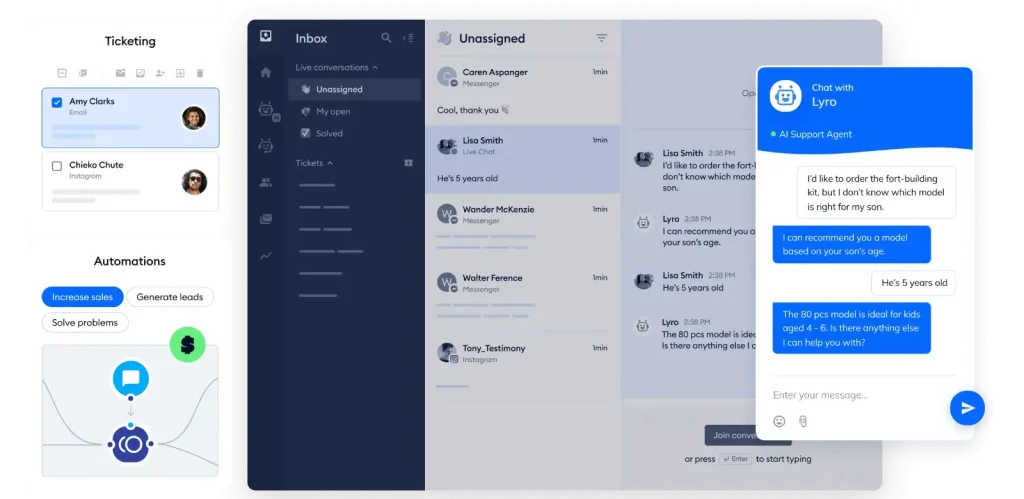Let’s be honest. We’ve all been there. Stuck in a phone queue listening to tinny hold music. Fumbling through a labyrinthine FAQ page that doesn’t answer our specific, urgent question. It’s frustrating. For customers, sure, but also for the support agents buried under a mountain of repetitive queries.
Well, that whole dynamic is shifting. And it’s not just a minor upgrade. It’s a fundamental reinvention of the support experience, powered by artificial intelligence. AI-powered customer service automation is here, and it’s less about replacing humans and more about… well, making them superheroes.
What Is This, Really? Beyond the Chatbot Cliché
When you hear “AI customer service,” you probably picture a basic chatbot. You know, the ones that often get stuck in a loop saying, “I’m sorry, I didn’t understand that.” But that’s the old model. Today’s AI is a different beast entirely.
Think of it less as a single robot and more as a central nervous system for your entire support operation. It’s a suite of technologies—including Natural Language Processing (NLP), machine learning, and predictive analytics—that work together to understand, route, and even solve customer issues autonomously. It’s the difference between a simple tool and a smart, collaborative partner.
The Core Components Working Behind the Scenes
So, what makes this tick? A few key pieces of tech:
- Intelligent Virtual Assistants (IVAs): These are the evolved, far-smarter cousins of the old chatbots. They don’t just match keywords; they understand context and intent. They can handle a multi-turn conversation that feels, remarkably, like talking to a person.
- AI-Powered Ticketing and Routing: This is the unsung hero. Instead of a customer service ticket landing in a general queue, AI analyzes the content and emotion of the request. It then instantly routes it to the exact right agent—or even the right part of an agent’s knowledge base—for a faster resolution. It’s like having a brilliant air traffic controller for support queries.
- Sentiment Analysis: The AI can “read” the customer’s mood. Is the user frustrated? Merely curious? Absolutely furious? By detecting emotional cues, the system can adjust its tone, prioritize urgent cases, and alert human agents when a delicate touch is needed.
The Tangible Benefits: It’s Not Just About Cutting Costs
Sure, efficiency is a huge driver. But the real magic happens in the value created for both businesses and their customers.
| For Businesses | For Customers |
| 24/7 instant response capability | Immediate answers, no matter the time zone |
| Massive reduction in repetitive agent workload | Faster resolution times for common issues |
| Consistent, on-brand messaging every single time | A seamless, frictionless experience |
| Valuable data insights from customer interactions | More time for human agents to solve complex, emotional problems |
The bottom line? AI handles the predictable, freeing up human intelligence for the nuanced, the creative, and the empathetic. It elevates the entire support team’s role from reactive problem-solvers to proactive relationship-builders.
A Real-World Glimpse: How It Works in the Wild
Imagine you’re a customer of a streaming service and your movie keeps buffering. Instead of searching a help center, you simply type, “My movie is stuttering and it’s really annoying.”
The AI doesn’t just see “buffering.” It understands the frustration. It might instantly run a diagnostic check on your connection, suggest a quick fix like lowering the stream quality, and then ask if that solved the problem. All in under a minute. If it doesn’t work, it seamlessly escalates the ticket to a human agent—with the entire conversation history and diagnostic data attached. The agent already knows the whole story. No starting from scratch.
Implementing AI Automation: A Realistic Roadmap
Okay, so you’re sold on the potential. But how do you actually get started with implementing AI for customer service without blowing your budget or confusing your team? It’s a marathon, not a sprint.
Here’s a practical approach:
- Start with a Specific, High-Volume Pain Point. Don’t try to boil the ocean. Identify one area that eats up a lot of time—like password resets, tracking orders, or basic billing questions. A focused pilot project has a much higher chance of success.
- Feed Your AI Good Data. An AI is only as smart as the information it learns from. Gather your past support tickets, chat logs, and knowledge base articles. The richer the data, the more accurate and helpful your AI will become. Garbage in, garbage out, as they say.
- Design for the Handoff. The goal isn’t 100% automation. It’s intelligent automation. Build clear pathways for the AI to hand over complex issues to a human agent. The transition should be invisible to the customer.
- Iterate and Train Continuously. This isn’t a “set it and forget it” tool. You need to monitor conversations, correct misunderstandings, and constantly refine the AI’s responses. It’s a learning system, after all.
The Human Touch in an Automated World
This is the part everyone worries about, right? Will robots take all the support jobs? The reality is far more interesting. AI is taking the drudgery out of the jobs.
By automating the routine, agents are empowered to focus on what they do best: showing empathy, handling complex escalations, building genuine customer relationships, and performing tasks that require creative problem-solving. The role of the customer service agent is evolving from a first-line responder to a specialized consultant and relationship manager. Frankly, that’s a much more rewarding job.
The Future Is Already Here
We’re already seeing glimpses of the next wave. Predictive support, where AI anticipates a problem before the customer even notices it. Hyper-personalization, where the system knows your entire history and tailors every interaction specifically to you. Voice AI that can handle nuanced, emotional phone calls with a startling degree of empathy.
The goal is no longer just to answer questions quickly. It’s to create a customer service experience that feels effortless, intuitive, and, dare we say, delightful. A service that doesn’t just solve your problem but makes you feel genuinely heard and valued along the way.
That’s the quiet revolution. It’s not about the whiz-bang technology itself, but the space it creates for more meaningful human connection. And honestly, isn’t that what great service was always supposed to be about?







More Stories
Sustainable Business Models for Circular Economies: It’s Not Just Recycling, It’s Rethinking Everything
Beyond the Hype: How Blockchain is Finally Untangling Our Supply Chains
A Guide to Developing a Business Intelligence Strategy